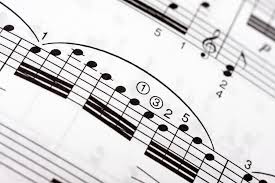Maximizing Worship Flow For Small Groups and Liturgy
 Last weekend I gave two keynotes and a workshop for an International Catholic Charismatic Young Adult Group called CUNAE. They were predominantly Korean and were on fire for God in ways that recalled my earlier involvement with my college and young adult groups. I am grateful for the opportunity to share.
Last weekend I gave two keynotes and a workshop for an International Catholic Charismatic Young Adult Group called CUNAE. They were predominantly Korean and were on fire for God in ways that recalled my earlier involvement with my college and young adult groups. I am grateful for the opportunity to share.
The workshop I gave was about worship music in small groups, and in particular, tons of practicals as to how to craft a worship set so that the worship would both resonate with the group, while also being as open to the Holy Spirit as one could. In short, how to maximize worship flow. These were my notes, but there was a lot more that I had shared, both in the context of the talk, and also afterwards.
Most of the worship sets are haphazardly done–they are from giant notebooks with only an alphabetical contents as a guide, one song per page. The poor worship leader has to choose songs from the book by flipping through the entirety of its contents, then grouping them together, hoping that the set works. And sometimes, it does.
This happens in liturgy, too. Many worship leaders choose songs from the “four-hymn sandwich” and not consider fitting the choice of song to a specific part of the liturgy. A liturgical service has its own flow, and the goal of a worship leader in those circumstances has a different criteria than that of a small group–to serve the mass; to serve the different parts of the mass when you are playing; also, focusing on the liturgical season, and in particular, texts of the readings, the introit, and the communion antiphon.
From a guitarists’ perspective (and perhaps also for the keyboardists), the biggest challenge is to not merely play these songs with the standard chords one has accepted when they first learned to play the instrument. Over the years, I have found this to be a mistake; there are literally thousands of ways to play a single chord on a guitar–it is a shock to many guitarists to hear this, but it is true–and there is a specific tone that you have to use to best resonate with the lyrics.
Worship Song Types and Directions
These tones are best captured by understanding the type of song you are singing, not based on musical style that it was crafted, but on its lyrics. There are four general musical types of song lyrics:
- Songs which teach some doctrine
- Songs which lead a person to humble/surrender themselves
- Songs which lead to action
- Songs of pure worship, resting in His love.
When you examine this above list, you can look at every single song that you encounter and put it in one or more of these four groups.
In addition, there are four general directions of song:
- Songs sung directly to God (God is addressed as “YOU”)
- Songs sung about God to others in attendance (God is addressed as “He”)
- Songs sung quoting God directly, paraphrasing from Scripture (God is “I”)
- Songs sung to the unrepentant.
So when a person sings a song, the first thing they have to do is to ask themselves where they are in the song. Most congregants just sing the song and not wrestle with it; we have to train ourselves to put ourselves in the song, look at the lyrics, and ask ourselves which direction we are going in. When we do this, our songs’ lyrics start growing its purpose, and the context of its lyrics start resonating with us.
Creating a Resource that Maximizes Flow
Now: to maximize worship flow in the context of a small group worship session, the worship leader has to get out a notebook (or, if they are more advanced, get out a Spreadsheet or Database program), and do the following:
1. Collect every song in the established repertoire–from songbooks, hymnals, and overheads.
2. ADD to that, every song outside the established repertoire that could be sung without need of a lyric sheet. To this, I include familiar hymns known by heart, simple repetitious praise choruses, echo songs (songs which the leader sings, and the congregation follows), and children’s songs.
3. For each song entry, write down the name of the song, and its page#/overhead #. Then write down the following:
a. Key
b. Tempo
c. Time Signature
At the most basic level, this is all you need. Make sure that the key you use is the best key for your group. In some cases, you may need to adjust it, as many worship songs of today use a range that is sung better by professional singers; in this case, lower it so that the low notes is around B-flat and the high notes is about E-flat.
If, after you type these songs in a database program, you can sort these songs and group them so that like-minded songs are right next to each other. It is between these songs that flow can be established easily; a song with a D key, medium tempo and 6-8 time signature can immediately switch to another such song with the same D key, medium tempo and 6-8 time signature, without stopping. The flow would not be disrupted in that case.
Second Stage of Grouping
Now, as your list grows, you may find that you need to break up the songs even further; in that case, also write down the following:
d. The lyrical type of song [Teaching / Humility / Action / Worship ]
e. The direction of the song [To God / to others / from God / to unrepentent]
For the lyrical type, in shorthand, I combine “Teaching” and “Humility”, because a “Teaching” song is a variation of a Humility song, on the part of the congregant, that is, the congregant admitting he does not know everything. They are written as follows:
Teaching / Humility – left paranthesis “(”
Action – left square bracket “[”
Worship – left squiggly bracket “{“
For the direction, in shorthand, I write an arrow for each entry.
To God: [north]
To others: [East]
From God: [South]
To unrepentant: [West]
Some songs have multiple directions, so have them both in. Many traditional hymns are sung as teaching songs, but the final verse, a Doxology, which then focuses solely upon God. This assumes that you would sing that verse.
Final Details in Grouping
There are a few tiny details that can be added to this list.
f. Does the song Ask , or does it Command?
g. Does the song have the word “Alleluia” or “Hallelujah”?
h. Does the song have the word “Yahweh”?
Songs which ask or command, can be used with a song in any direction. A song to God could Ask God to bring revival or change our hearts. A song to others could ask or command the others in the room to focus on God. A song from God could be a paraphrase quoting from Scripture to “Be Not Afraid.” A song to the repentant could ask them to “come Home.”
Songs which have “Alleluia” or “Hallelujah” is good to mark down, so that in the season of Lent, such songs could be avoided, and, in the season of Easter, such songs could be emphasized.
Songs which have “Yahweh” have been asked by the Church to disregard; if such a song is in your playlist, you are to find a creative means to work around that song. In some cases, the song’s author has crafted an alternate rendering of the song so that there is no conflict. In others, perhaps the song uses “Yahweh” in a verse, not a chorus; in which case, you just don’t sing that verse.
Printing the List
Now that you have your full list of songs (this is going to take days, perhaps weeks), sort the list by key, tempo, and time signature, and print the list–with the details of song type, direction, Ask/Command, Alleluia and Yahweh indicators in tow. Print it.
Feel free to print out the list so that it is sorted in different ways: sort it alphabetically. Or sort it numerically in the song list. If you use a database app on your mobile device, make sure this list is imported in there.
This list will be the basis of your worship flow. By examining this list, you can immediately find those like-minded songs and group them together. Within the context of this group, then, the goal is to craft a set that tells a story.
Using the List
In this set, you would want to move from where the person is initially, to the Holy of Holies. A lot of people would have the song flow from fast, fun songs, and have it move towards the slow, worship songs. Or, you can also start with a slow, penitential minor-key song, and have it move to a joyous aftermath of God’s mercy. It takes practice.
Next Steps: Crafting A Full Songbook
This list is just a first step. A worship leader can actually go even more efficient if they were to craft their own personalized worship resource that gets rid of the giant notebook of songs. By this, instead of putting one song per page, put multiple songs–of the same key, tempo and time signature on the same page, or in as few pages as possible. This you could do, legally, if you have a music reprinting license like one from Christian Copyright Licensing Inc (ccli.com).
To do this, type out the lyrics of the song in such a way where it is in the smallest font that you can read; I like Arial Narrow. Add multiple columns on this single letter-sized page–start with two, but see if you can move it to three, or even four. Shrink down the lyrics by replacing words with numbers, or removing vowels from longer words. This is only to be seen by the worship leader, not the congregation. The congregation would still use the hymnal, songbook, or overheads.
Group the chords, and put them all on a single line, in a different font, bolded. Find every way to shrink the song down that best affects your readability. The goal is to get as many like-minded songs on a single page as possible, but if you shrink the songs so small that they are indecipherable, it becomes useless. Find that proper balance between what you can handle, and yet efficient rendering of the song itself.
This will take weeks, if not months. Do a little at a time, every day, to ensure that you don’t get burnt out. But the end result, is that you would have a worship resource that will maximize flow in your group. You will have all the songs in a single page, that can be looked at on one glance, and you can have the Holy Spirit help move you to find the songs that best fit the moment.
I have even more to share. Does this information help you? If you want advice in helping craft these lists, or questions, feel free to ask them below. If you need help in crafting these cheat-sheet songsheets, I am toying with the idea of making myself available to help, through a site like fiverr.com. Would this be something that you would want to try?








